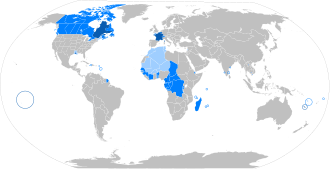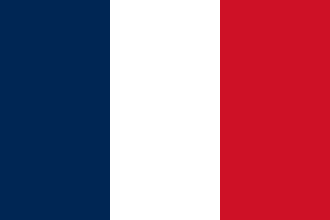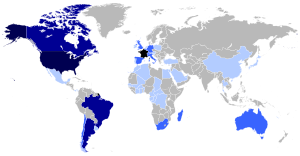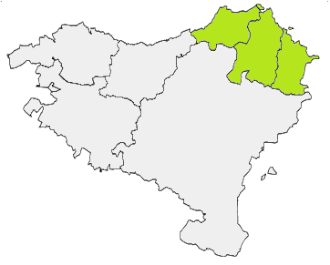Discover Your Roots
SIGN UPDiscover Your Roots
SIGN UPFrench is a gender-neutral name of American origin that means "From France." It is associated with something of, from, or related to France, including the French language, people, and cuisine. In arts and media, the name is linked to various cultural references such as the British rock band The French, the live-action episode "French" from The Super Mario Bros. Super Show!, and the film "Française." Additionally, the name is also connected to other uses like the French surname, military jacket, mustard condiment, chess opening, and a type of kiss known as the French kiss. With its origins and associations deeply rooted in the culture and heritage of France, the name French captures the essence of the nation and its traditions.

French is a Romance language that originated from the Vulgar Latin of the Roman Empire and evolved from Northern Old Gallo-Romance, a descendant of the Latin spoken in Northern Gaul. It has been influenced by native Celtic languages of Northern Roman Gaul and the Germanic Frankish language. With French and Belgian colonialism, the language spread to the Americas, Africa, and Asia, leading to the establishment of French-based creole languages. French is an official language in 26 countries and is one of the most geographically widespread languages globally. It is estimated to have about 310 million speakers, making it the second most widely spoken mother tongue in the European Union. French has a rich history as an international language of literature and scientific standards and is used as a primary or second language by many international organizations, including the United Nations and the European Union. It is also among the top five most studied languages worldwide.

French Indochina, previously known as French Indo-China, was a group of French dependent territories in Southeast Asia from 1887 to 1954. It started as a federation of French colonies and later transformed into a confederation of French associated states. The territories included Cambodia, Laos, Guangzhouwan, Cochinchina, and the Vietnamese regions of Tonkin and Annam. The Second French Empire colonized Cochinchina in 1862, followed by establishing a protectorate in Cambodia in 1863. Under the French Third Republic, the various protectorates were consolidated into one union in 1887. The French exploited the region's resources and contributed to improvements in the health and education system. However, deep divides between the native population and the colonists led to sporadic rebellions. After World War II, the colony was administered by the Vichy government and later under Japanese occupation. The Vietnamese resistance in the First Indochina War ultimately led to the end of French Indochina with the Geneva Accords of 1954, granting independence to Laos, Cambodia, and Vietnam. Throughout the 19th century, French involvement in Vietnam increased, with military interventions and protection of Catholic missionaries. The French conquest of Cochinchina in 1858 marked a significant turning point in the colonial history of the region.

French people, also known as Les Français, are a nation with a rich and diverse heritage primarily located in Western Europe. They share a common French culture, history, and language, which are closely identified with the country of France. The French people are descended from a mix of Romans, Gauls, Germanic peoples, and Norsemen, who have contributed to the unique ancestry of the French population. Additionally, France is home to various regional ethnic minorities with distinct lineages, languages, and cultures, such as the Bretons, Occitans, Basques, Catalans, Germans, Corsicans, and Flemings.Modern French society is characterized by its inclusivity and diversity, with a history of inward migration from various parts of the world. This has resulted in a melting pot of cultures and traditions within the country. While the French government historically promoted assimilation, the approach towards immigrants has evolved, with a focus on integration while allowing newcomers to retain their distinctive cultures. French citizens equate their nationality with citizenship, as defined by French law.French people and individuals of French descent can be found not only in mainland France but also in overseas departments and territories of France, as well as in various foreign countries with significant French-speaking population groups. France has historically been open to immigration, although there have been changes in recent years, with debates surrounding the integration of immigrants and the principles underlying the European Community.Application for French citizenship is often seen as a renunciation of previous state allegiance, unless dual

A French braid, also known as a French plait, is a classic braided hairstyle that involves weaving three sections of hair from the crown of the head to the nape of the neck. Unlike a simple braid where all the hair is divided into three sections at once, a French braid starts with three small sections at the crown of the head and gradually adds more hair to each section as it crosses in from the side. This results in a smoothly woven pattern over the scalp. One unique feature of the French braid is that individuals can braid their own hair without assistance, although the difficulty may vary based on hair type and length. The French braid is known for its sleek and elegant appearance and is often used to restrain shorter hair from the top of the head. It is more complex to construct than a simple braid, and variations such as the Dutch braid and fishtail braid offer different looks. The French braid's history dates back to the 19th century and has inspired variations in hairstyles for both humans and animals.

The French Basque Country, also known as the Northern Basque Country, is a region located in the western part of the French department of the Pyrénées-Atlantiques. It comprises three former historic French provinces: Lower Navarre, Labourd, and Soule. The region is presided over by Jean-René Etchegaray and is home to approximately 309,723 inhabitants spread across 158 municipalities. The territory is bordered by the department of Landes to the north, the Bay of Biscay to the west, the Southern Basque Country to the south, and Béarn to the east. The department of the Pyrénées-Atlantiques is divided into three districts: Bayonne, Oloron-Sainte-Marie, and Pau. The French Basque Country is a popular tourist destination, known for its agricultural heritage and beautiful beaches. Its chief towns are Bayonne and Biarritz, which are part of the Basque Eurocity Bayonne-San Sebastián Euroregion. Key cities in the region include Bayonne, Biarritz, and Saint-Jean-de-Luz. With its distinct cultural and natural attractions, the French Basque Country offers a unique experience for visitors.
All images displayed on this page are sourced from Wikipedia or Wikimedia Commons.We use these images under their respective Creative Commons or public domain licenses. Wherever applicable, author attributions and license information are provided. If you believe an image is used incorrectly or outside its license terms, please contact us so that we can review and correct the issue.